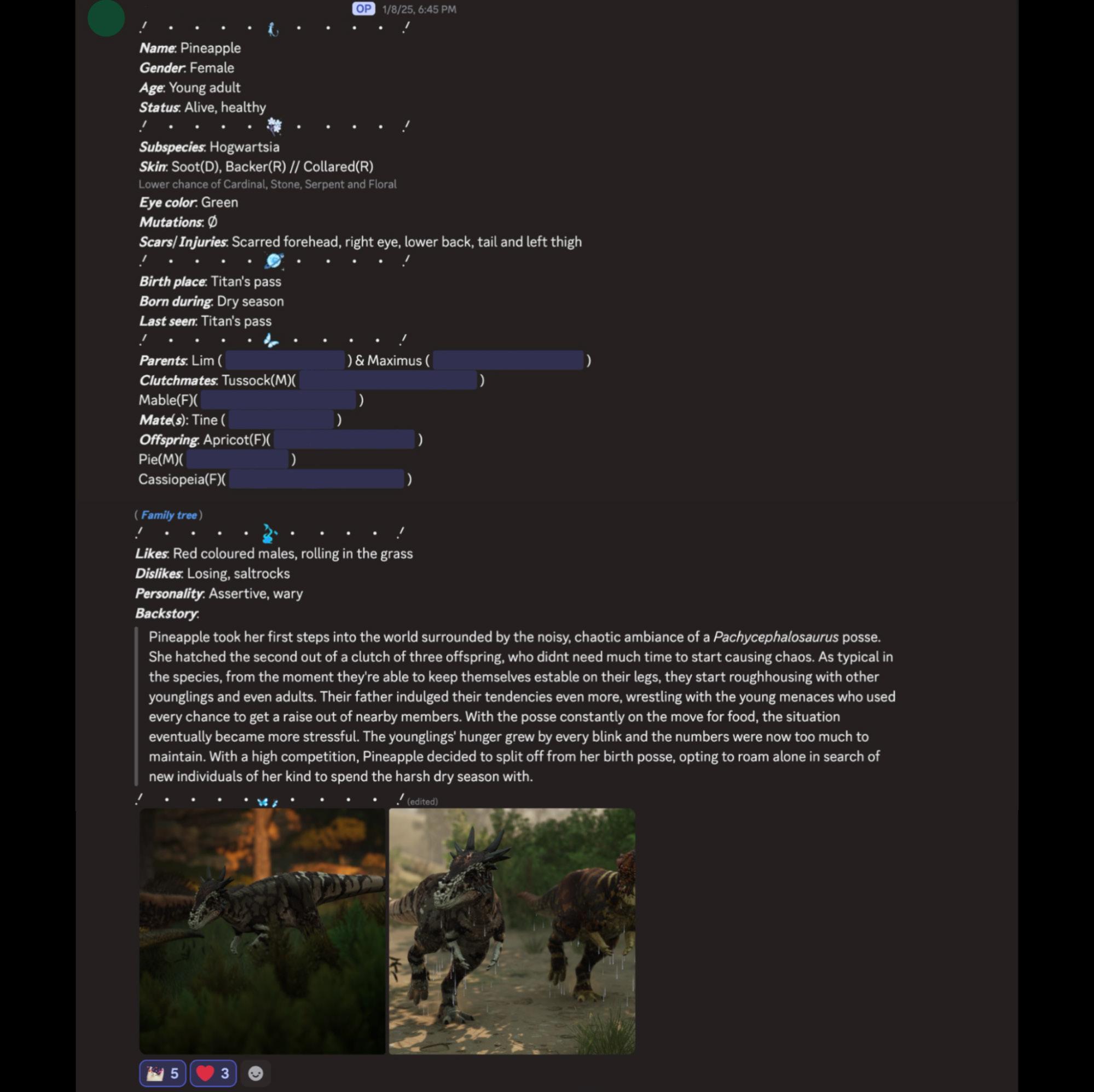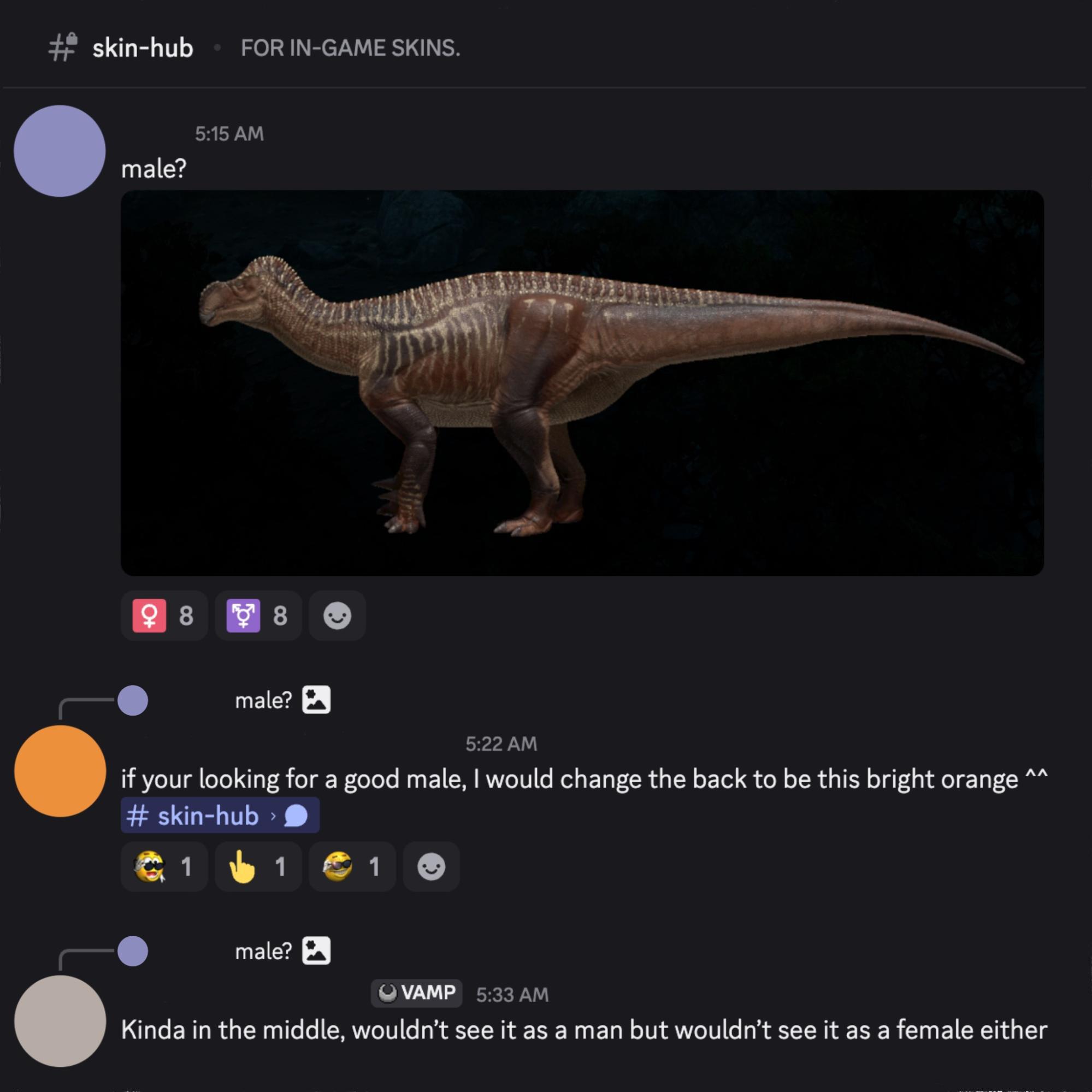Gaming the Narrative
PARTICIPATORY CULTURE AND AFFINITY SPACES
IN THE PRIMORDIAL TYRANTS: REALISM DISCORD SERVER
ACADEMIC ESSAY
FRANCOIS FOUCHÉ
221054
6 JUNE 2025

PARTICIPATORY CULTURE AND AFFINITY SPACES
FRANCOIS FOUCHÉ
221054
6 JUNE 2025
Figure 1 Screenshot of a trailcam from the PTR “trailcams” channel.
Figure 2 Example of community feedback on the PTR skin-hub channel.
In Confronting the Challenges of Participatory Culture: Media Education for the 21st Century (Jenkins, 2006), Henry Jenkins defines participatory culture as a digital environment where users actively engage in content creation, collaboration, and shared storytelling (Jenkins, 2006). This essay applies Jenkins’s theory to Primordial Tyrants: Realism (PTR), a Discord community server for the MMO dinosaur survival game Path of Titans (Alderon Games, 2020). By analysing how PTR fosters an immersive, realism-based gameplay experience, I will explore how players create narrative threads through active participation, collectively shaping the ingame world of Gondwa , a world otherwise unconstrained by an overarching narrative.
PTR is an application-only server, therefore requiring active participation. It is designed to enforce realism in player behaviour and interactions, adhering strictly to server rules and detailed character profiles for playable species. PTR stands out from other Path of Titans (Alderon Games, 2020) community servers by exclusively using Primordial Tyrants character mods alongside the base game’s “vanilla” playables. As an active player on PTR since June 16, 2024, I have engaged extensively with players in-game, across various server channels and personal messages on Discord.
A key focus of this essay is the role of the trailcams channel, a unique feature in PTR that mimics real-world wildlife trail cameras, allowing players to document their characters’ movements, genetics, interactions and relationships. This channel serves as a central narrative tool, reinforcing the server’s realism-based immersion while exemplifying Jenkins’s concept of participatory culture through performance and simulation (Jenkins, 2006, p. 4).
By examining trailcams and other community-driven storytelling mechanisms such as the
skin-hub , this essay will highlight how PTR functions as a dynamic, player-driven digital space where realism and creativity intersect.
In Confronting the Challenges of Participatory Culture: Media Education for the 21st Century (Jenkins, 2006, p. 7), Jenkins defines participatory culture as a space with “low barriers to artistic expression and civic engagement,” where creativity is encouraged, and knowledge is shared through informal mentorship. Jenkins also highlights the importance of social connection, emphasising that participants must feel their contributions are valued and play a meaningful role in forming a community between participants (Jenkins, 2006, p. 7).
In his seminal publication, Jenkins describes four types of participatory culture that shape digital communities: affiliations, expressions, collaborative problem-solving, and circulations (Jenkins, 2006, p. 8). Affiliations refer to memberships in online groups centred around shared media interests, such as social networks, gaming servers, and message boards (Jenkins, 2006, p. 8). Expressions involve the creation of new media content, including fan fiction, modding, digital art, and video mash-ups, allowing participants to remix and reinterpret existing material (Jenkins, 2006, p. 8). Collaborative problem-solving highlights the collective efforts of community members to achieve common goals, whether through wiki contributions, alternative reality games, or informal learning platforms (Jenkins, 2006, p.
8). Finally, circulations focus on how media is distributed and reshaped, with users influencing content flow through blogging, podcasting, and social media (Jenkins, 2006, p. 8).
Jenkins argues that these forms of participatory culture allow for ideal informal learning environments labelled “affinity spaces” (Jenkins, 2006, p. 9). These spaces thrive on shared interests rather than demographic similarities, allow flexible participation based on skill and interest and encourage peer-to-peer teaching. (Jenkins, 2006, p. 9). Affinity spaces differ from formal learning in key ways: they are experimental, adaptable, community-driven, and responsive to individual needs, whereas formal education tends to exhibit the opposite approach (Jenkins, 2006, p. 9). Jenkins describes these participatory affinity spaces as “highly generative environments, from which new aesthetic experiments and innovations emerge”, stating that amateurs and hobbyists who participate in community-driven learning and engagement emerge as media-makers themselves, changing the way media is consumed and created (Jenkins, 2006, p. 9).
When examining Primordial Tyrants: Realism (PTR) through Jenkins’s framework as an affinity space where players create their own media via consumption, affiliations, expressions, and collaborative problem-solving emerge as key components of its participatory culture. As an affiliation -based community, PTR unites players who share a commitment to realism-based gameplay, fostering a space where individual narratives are developed through character profiles, immersive roleplay scenarios, and visual media shared in the server’s many channels. Players express themselves individually as they create and share their unique character interactions, skins and dimorphism, contributing to the server’s overarching narrative. Meanwhile, collaborative problem-solving is central to PTR’s structure, as members work together to navigate in-game interactions, enforce rules, and maintain the realism essential
to the server’s immersive experience, demonstrated by the server’s questions, profiles and reporting channels.
A prime example of participatory culture in PTR is the trailcams channel, the server’s primary storytelling device. Inspired by real-world wildlife trail cameras, trailcams allow players to document their active characters, serving as dynamic, customisable character sheets within the parameters of the trailcams guidelines. Within this thread-formatted system, players track their character’s lore, genetics (dominant and recessive skins, as well as any applicable mutations such as albinism, chronic illness etc.), relationships (including parents, siblings, mates, and offspring), and personality, all within the framework of the character’s relevant species profile.
Trailcams exist as purely participatory artefacts on the Primordial Tyrants: Realism Discord server and are not required once a character is made and forms subsequent relationships with other players’ characters. The ultimate aim of this channel, according to the Trailcam Guidelines post on the PTR Discord ( Primordial Tyrants: Realism , 2023), is “a way for players to tell the stories of their dinosaurs. You can write in any way you like, such as researchers making logs about specimens or just freeform writing” ( Primordial Tyrants: Realism , 2023).
This open-ended approach to narrative construction demonstrates how creative freedom and community norms intersect, encouraging players to experiment with tone, form, and even pseudo-scientific detail. The trailcams channel, therefore, exemplifies Jenkins’s generative affinity space, where new forms of storytelling emerge from both in-game and server-related

Screenshot of a trailcam from the PTR “trailcams” channel.
Note: Anonymous on the PTR Discord, 2025, (Primordial Tyrants: Realism Discord)

Example of community feedback on the PTR skin-hub channel.
Note: Anonymous on the PTR Discord, 2025, (Primordial Tyrants: Realism Discord)
community engagement and their contributions through participatory cultures (Jenkins, 2006, p. 9).
Another channel on the PTR Discord server that lends itself to Jenkins’s affinity space via participatory cultures, especially regarding player-to-player interactions, is the skin-hub. In a Path of Titans server grounded in simulated realism, character skins (encompassing colours, patterns, and visual traits) serve as the primary means of communicating information such as sex, health, and fitness. These visual cues play a crucial role in shaping how players interpret and interact with one another, within the parameters of the appropriate species profile, in-game. The skin-hub serves as a space where players can share screenshots of their characters’ skins and ask for community feedback, especially regarding the perceived sex of their character. When viewed through the lens of Jenkins’s seminal work, it becomes clear that these server channels act as informal and collaborative learning environments, where players engage in narrative, character, and individual media creation, exemplifying his theory on the intersection of participatory cultures (Jenkins, 2006, p. 9).
By integrating these elements, trailcams and PTR’s other community-driven channels reinforce simulated realism while demonstrating how player engagement actively shapes the broader storytelling of a server otherwise unconstrained by an in-game narrative, allowing Path of Titans players active on PTR to develop not only their in-game personas but also transferable creative and collaborative skills.
When examined through Confronting the Challenges of Participatory Culture: Media Education for the 21st Century (Jenkins, 2006), it becomes evident that digital gaming
communities such as the Primordial Tyrants: Realism (PTR) Discord server operate as a prime example of Jenkins’s writing on participatory cultures and affinity spaces.
Through players actively participating in creating a community based on immersion, simulation and roleplay via server channels like trailcams and skin-hub, PTR allows for an informal learning environment where these elements are not only encouraged but necessary to the overall experience in realism-based Path of Titans gameplay.
By supporting the development of transferable creative and collaborative skills through shared investment in independent participatory narrative creation, peer-to-peer teaching, and realism-based player interactions, Primordial Tyrants: Realism becomes more than just a Discord gaming server; it turns into a generative space where players become co-authors of an evolving digital ecosystem.
Alderon Games. (2020). Path of Titans. Pathoftitans.com. https://pathoftitans.com/
Clinton, K., Jenkins, H., Purushotma, R., Robinson, A., Weigel, M. (2006). Executive Summary, Enabling Participation. In Confronting the Challenges of Participatory Culture: Media Education for the 21st Century (pp. 3–9). The MacArthur Foundation. https://www.macfound. org/media/article_pdfs/jenkins_white_paper.pdf
Primordial Tyrants: Realism. (2023). Primordial Tyrants: Realism. Primordial Tyrants: Realism Discord. https://www.google.com/url?q=https://discord.com/channels/11064487315801457 54/1137561561309913098&sa=D&source=editors&ust=1752741087506896&usg=AOvVaw 1YvUKkeXuR9zg3_2ZW4WN_
© 2025 The Open Window